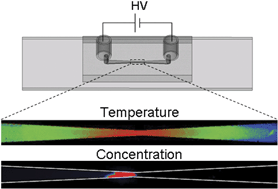Theoretical and numerical analysis of temperature gradient focusing via Joule heating†
Abstract
We present a detailed theoretical and numerical analysis of temperature gradient focusing (TGF) via Joule heating—an analytical species concentration and separation technique relying upon the dependence of an analyte's velocity on temperature due to the temperature dependence of a buffer's ionic strength and viscosity. The governing transport equations are presented, analyzed, and implemented into a quasi-1D numerical model to predict the resulting temperature, velocity, and concentration profiles along a microchannel of varying width under an applied electric field. Numerical results show good agreement with experimental trials presented in previous work. The model is used to analyze the effects of varying certain geometrical and experimental parameters on the focusing performance of the device. Simulations also help depict the separation capability of the device, as well as the effectiveness of different buffer systems used in the technique. The analysis provides rule-of-thumb methodology for implementation of TGF into analytical systems, as well as a fundamental model applicable to any lab-on-a-chip system in which Joule heating and temperature-dependent electrokinetic transport are to be analyzed.


 Please wait while we load your content...
Please wait while we load your content...